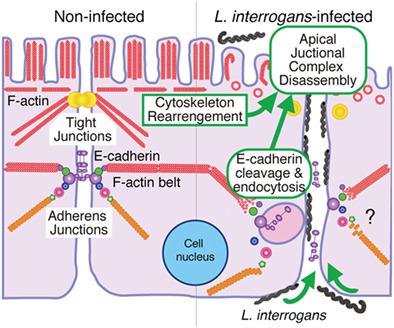当前位置:
X-MOL 学术
›
Cell. Microbiol.
›
论文详情
Our official English website, www.x-mol.net, welcomes your
feedback! (Note: you will need to create a separate account there.)
Disassembly of the apical junctional complex during the transmigration of Leptospira interrogans across polarized renal proximal tubule epithelial cells
Cellular Microbiology ( IF 2.6 ) Pub Date : 2021-04-16 , DOI: 10.1111/cmi.13343 Isabel Sebastián 1 , Nobuhiko Okura 2 , Bruno M Humbel 3, 4, 5 , Jun Xu 1, 6 , Idam Hermawan 1 , Chiaki Matsuura 1 , Malgorzata Hall 3 , Chitoshi Takayama 2 , Tetsu Yamashiro 1 , Shuichi Nakamura 7 , Claudia Toma 1
Cellular Microbiology ( IF 2.6 ) Pub Date : 2021-04-16 , DOI: 10.1111/cmi.13343 Isabel Sebastián 1 , Nobuhiko Okura 2 , Bruno M Humbel 3, 4, 5 , Jun Xu 1, 6 , Idam Hermawan 1 , Chiaki Matsuura 1 , Malgorzata Hall 3 , Chitoshi Takayama 2 , Tetsu Yamashiro 1 , Shuichi Nakamura 7 , Claudia Toma 1
Affiliation

|
Bacterial pathogens have evolved multiple strategies to disassemble epithelial cell apical junctional complexes (AJCs) and infect epithelial cells. Leptospirosis is a widespread zoonotic infection, mainly caused by Leptospira interrogans, and its dissemination across host cell barriers is essential for its pathogenesis. However, the mechanism of bacterial dissemination across epithelial cell barriers remains poorly characterised. In this study, we analysed the interaction of L. interrogans with renal proximal tubule epithelial cells (RPTECs) and found that at 24 hr post-infection, L. interrogans remain in close contact with the plasma membrane of the RPTEC by extracellularly adhering or crawling. Leptospira interrogans cleaved E-cadherin and induced its endocytosis with release of the soluble N-terminal fragment into the extracellular medium. Concomitantly, a gradual decrease in transepithelial electrical resistance (TEER), mislocalisation of AJC proteins (occludin, claudin-10, ZO-1, and cingulin) and cytoskeletal rearrangement were observed. Inhibition of clathrin-mediated E-cadherin endocytosis prevented the decrease in TEER. We showed that disassembly of AJCs in epithelial cells and transmigration of bacteria through the paracellular route are important for the dissemination of L. interrogans in the host.
中文翻译:

问号钩端螺旋体穿过极化的肾近端小管上皮细胞迁移过程中顶端连接复合体的拆卸
细菌病原体已经进化出多种策略来分解上皮细胞顶端连接复合物 (AJC) 并感染上皮细胞。钩端螺旋体病是一种广泛传播的人畜共患病,主要由问号钩端螺旋体引起,其跨宿主细胞屏障的传播对其发病机制至关重要。然而,细菌通过上皮细胞屏障传播的机制仍然缺乏特征。在这项研究中,我们分析了问号L.与肾近端小管上皮细胞(RPTECs)的相互作用,发现在感染后24小时,问号L.通过细胞外粘附或爬行与RPTEC的质膜保持密切接触. 问号钩端螺旋体裂解E-钙粘蛋白并诱导其内吞作用,将可溶性N-末端片段释放到细胞外介质中。同时,观察到跨上皮电阻 (TEER) 逐渐降低、AJC 蛋白(occludin、claudin-10、ZO-1 和 cingulin)的错误定位和细胞骨架重排。网格蛋白介导的 E-钙粘蛋白内吞作用的抑制阻止了 TEER 的降低。我们表明,上皮细胞中 AJC 的拆卸和细菌通过细胞旁途径的迁移对于问号 L.在宿主中的传播很重要。
更新日期:2021-04-16
中文翻译:

问号钩端螺旋体穿过极化的肾近端小管上皮细胞迁移过程中顶端连接复合体的拆卸
细菌病原体已经进化出多种策略来分解上皮细胞顶端连接复合物 (AJC) 并感染上皮细胞。钩端螺旋体病是一种广泛传播的人畜共患病,主要由问号钩端螺旋体引起,其跨宿主细胞屏障的传播对其发病机制至关重要。然而,细菌通过上皮细胞屏障传播的机制仍然缺乏特征。在这项研究中,我们分析了问号L.与肾近端小管上皮细胞(RPTECs)的相互作用,发现在感染后24小时,问号L.通过细胞外粘附或爬行与RPTEC的质膜保持密切接触. 问号钩端螺旋体裂解E-钙粘蛋白并诱导其内吞作用,将可溶性N-末端片段释放到细胞外介质中。同时,观察到跨上皮电阻 (TEER) 逐渐降低、AJC 蛋白(occludin、claudin-10、ZO-1 和 cingulin)的错误定位和细胞骨架重排。网格蛋白介导的 E-钙粘蛋白内吞作用的抑制阻止了 TEER 的降低。我们表明,上皮细胞中 AJC 的拆卸和细菌通过细胞旁途径的迁移对于问号 L.在宿主中的传播很重要。











































 京公网安备 11010802027423号
京公网安备 11010802027423号